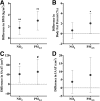Longitudinal Associations Between Ambient Air Pollution With Insulin Sensitivity, β-Cell Function, and Adiposity in Los Angeles Latino Children
- PMID: 28137791
- PMCID: PMC5482082
- DOI: 10.2337/db16-1416
Longitudinal Associations Between Ambient Air Pollution With Insulin Sensitivity, β-Cell Function, and Adiposity in Los Angeles Latino Children
Abstract
Evidence suggests that ambient air pollution (AAP) exposure may contribute to the development of obesity and type 2 diabetes. The objective of this study was to determine whether exposure to elevated concentrations of nitrogen dioxide (NO2) and particulate matter with aerodynamic diameter <2.5 (PM2.5) had adverse effects on longitudinal measures of insulin sensitivity (SI), β-cell function, and obesity in children at high risk for developing diabetes. Overweight and obese Latino children (8-15 years; n = 314) were enrolled between 2001 and 2012 from Los Angeles, CA, and followed for an average of 3.4 years (SD 3.1 years). Linear mixed-effects models were fitted to assess relationships between AAP exposure and outcomes after adjusting for covariates including body fat percent. Higher NO2 and PM2.5 were associated with a faster decline in SI and a lower SI at age 18 years, independent of adiposity. NO2 exposure negatively affected β-cell function, evidenced by a faster decline in disposition index (DI) and a lower DI at age 18 years. Higher NO2 and PM2.5 exposures over follow-up were also associated with a higher BMI at age 18 years. AAP exposure may contribute to development of type 2 diabetes through direct effects on SI and β-cell function.
© 2017 by the American Diabetes Association.
Figures



Comment in
-
Ambient Air Pollution and Type 2 Diabetes: Do the Metabolic Effects of Air Pollution Start Early in Life?Diabetes. 2017 Jul;66(7):1755-1757. doi: 10.2337/dbi17-0012. Diabetes. 2017. PMID: 28637828 Free PMC article. No abstract available.
References
-
- Menke A, Casagrande S, Geiss L, Cowie CC. Prevalence of and trends in diabetes among adults in the United States, 1988-2012. JAMA 2015;314:1021–1029 - PubMed
MeSH terms
Substances
Grants and funding
LinkOut - more resources
Full Text Sources
Other Literature Sources
Medical
Molecular Biology Databases
Miscellaneous

